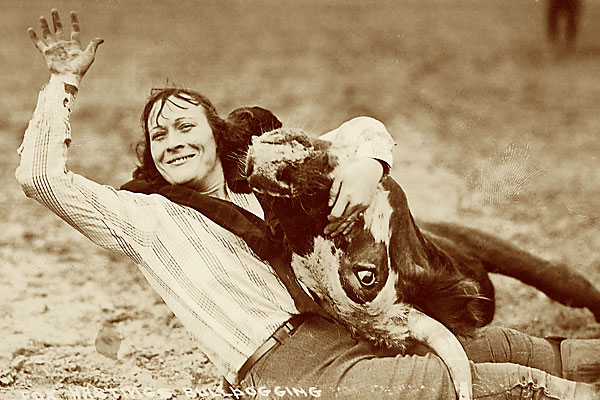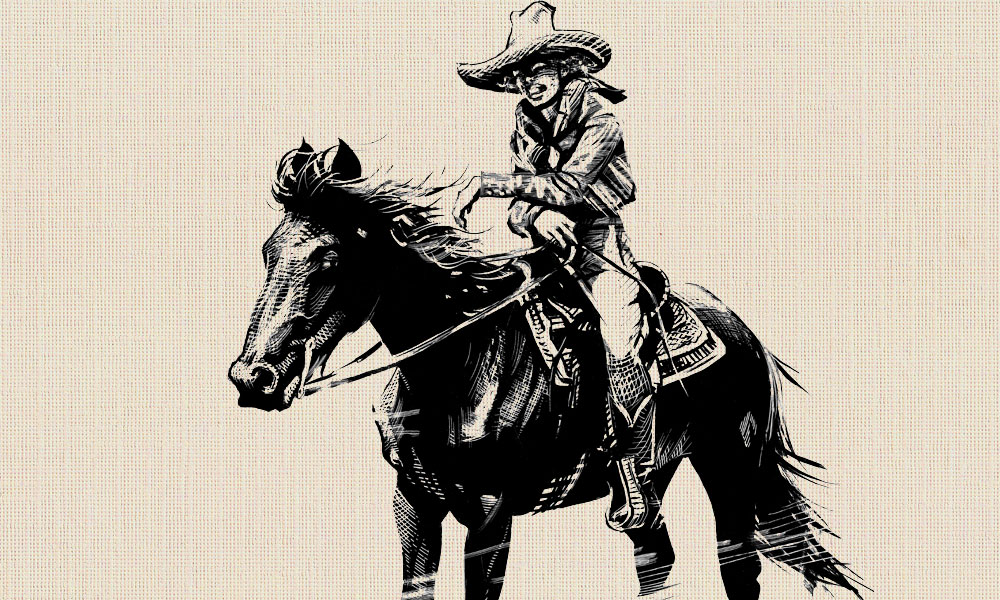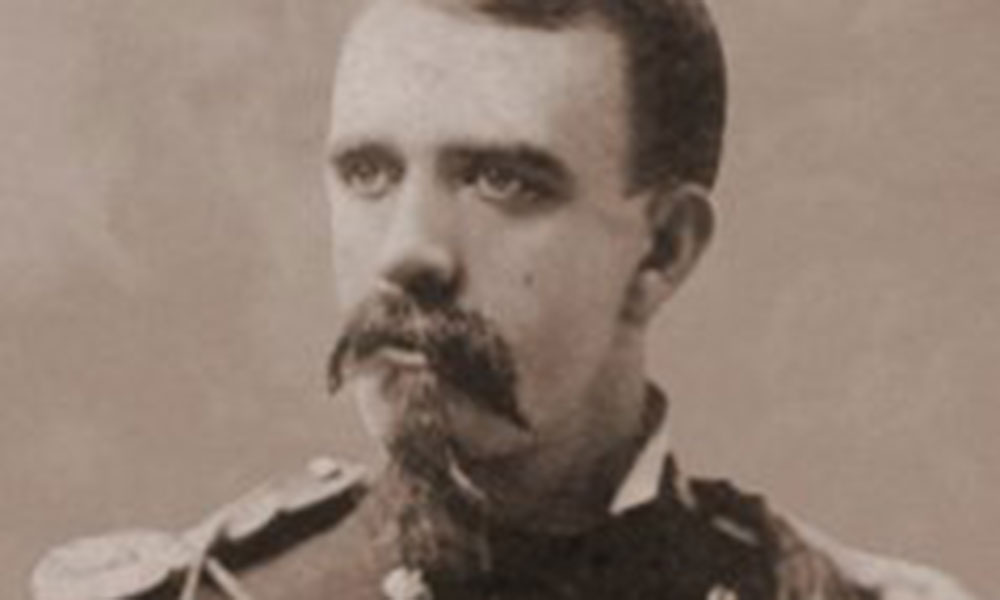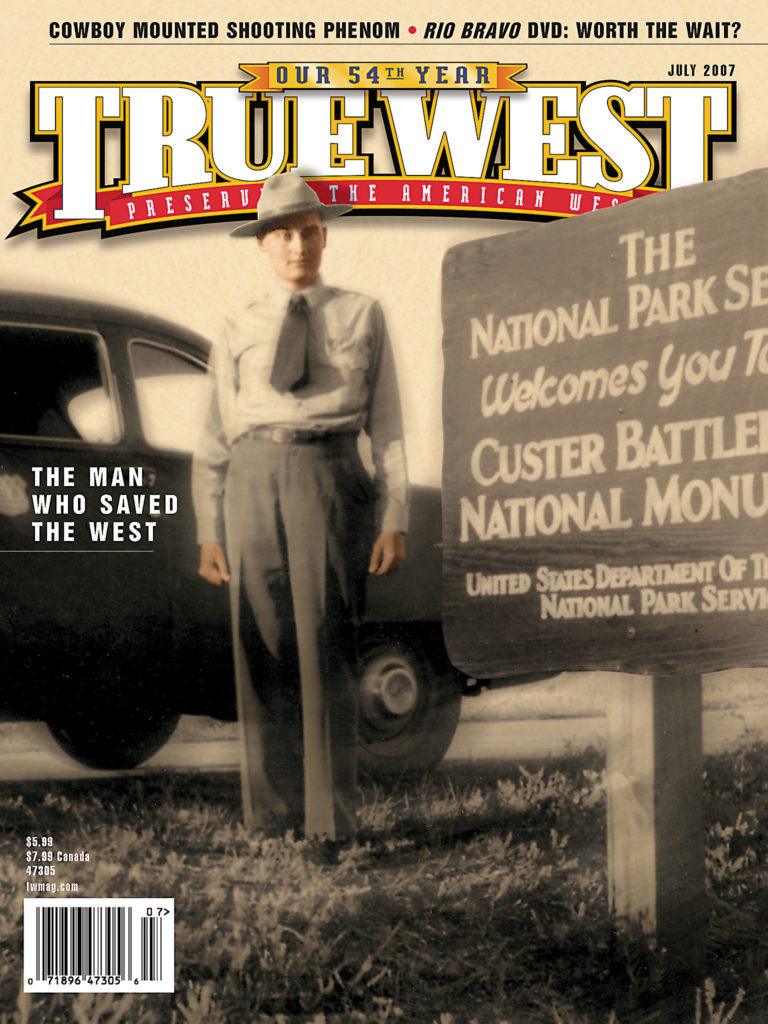 You have to wonder if it was the sexy cowboy or the opportunity to break out of the “woman’s world” that most prompted young Eloise Fox to run away from a convent school at the age of 14.
You have to wonder if it was the sexy cowboy or the opportunity to break out of the “woman’s world” that most prompted young Eloise Fox to run away from a convent school at the age of 14.
But run she did, marrying the cowboy who would help her reach stardom in the rodeo world.
Paul Raymond “Mike” Hastings was a noted bulldogger and took his wife to Irwin Brother’s Wild West Show, where she started out competing on bucking broncs and in trick riding matches. Eventually he’d show her the ropes—literally and figuratively—of bulldogging, making her a superstar.
Even the choice of her new name gives a clue that she knew she was going to be special—she dropped Eloise and went by Fox Hastings, a name the press adored.
She joined a world unlike her own. Outside the rodeo world, women couldn’t even vote. The few who worked outside the home—waitress, clerk, school marm—made less than half that of men. And the idea of a “woman athlete” was comical. But in the rodeo world, things were different. North America’s first professional female athletes were rodeo performers. They earned far more than women in traditional fields, and they openly complained when that pay was still less than that of the cowboys. “Whatever disadvantages they may have suffered relative to the men … cowgirls were nonetheless the first significant group of professional women athletes in North America and the first to be taken seriously by the public and the press,” notes Candace Savage in her 1996 book Cowgirls.
Women trace their entry into professional rodeo life back to 1897 at the Cheyenne Frontier Days in Wyoming (a territory that also was the first, in 1890, to give women the right to vote—30 years before the 19th Amendment was ratified). By 1916, about 240 women were competing in the rodeo circuit. Fox Hastings was one of them.
But the rodeo world wasn’t totally insulated from the outside—there were rules and taboos to consider, and one taboo was women appearing “masculine”—not only was it “un-ladylike,” but it suggested what was then called “perversion” and today is more simply known as lesbianism.
So female rodeo performers were careful to show off their feminine side. For years, they competed in skirts, sometimes split, but still skirts. Fox often wore ribbons in her red hair and was known for the bandanna she draped around her shoulders. Consider how the press described her: “To the rodeo crowd she is Fox Hastings, cowgirl extraordinaire. To neighbors she is Mrs. Mike Hastings, a good cook and tidy housekeeper.”
Or notice the surprise of The New York Times reporter who admitted, “We went behind the scenes expecting to interview half a dozen tomboys, but found ourselves in the presence of six mistresses of dignified deportment.”
The cowgirls had a powerful new message to convey, as Savage reports: “Maidenly dignity would have to look after itself when there were bucking broncs to conquer, steers to wrestle and ‘suicide drags’ to perform. Nice girls, the cowgirls’ performances said, were tough and courageous. Nice girls could get physical.”
But this was a double-edged sword. “No matter how hard they tried, rodeo cowgirls couldn’t quite get it right,” Savage notes. “Had they refused to act feminine, they would have been outcasts. By happily agreeing to do so, they marked themselves as specialty acts. In 1924, when a group of women [Fox among them] asked to enter the men-only events in Pendleton, and thereby get into the official running for the All Round Cowboy award, their request was promptly turned down. Cowgirls were not cowboys. It was only natural that women should have fewer opportunities to compete. It was only natural that they should compete for smaller purses than the guys.”
And no matter how many trails they blazed, politics wasn’t one of them. “From Annie Oakley onwards, few cowgirls had ever declared themselves to be feminists,” Savage writes. “In the view of most women’s suffragists, women were moral and pure, the natural opponents of evil such as promiscuity and booze. Rodeo and Wild West cowgirls—many of whom were much-married and knew how to enjoy a drink—represented … earthier interests. They were not intellectuals or middle-class church ladies, who strove to articulate worthy ideals in well-rounded sentences. They were entertainers, and their message, if they had one, was expressed in their performances.”
In 1924, Fox made her debut as a bulldogger, a sport that saw very few women. Although she would be touted as the “world’s only female bulldogger,” that wasn’t true—she was actually the second, following Tillie Baldwin by a decade. But that doesn’t diminish her talent.
After first bulldogging in Fort Worth, she showed off her new skills at the Cattlemen’s Convention Rodeo in Houston where the press called her “the outstanding act of the entire event.” She undoubtedly earned the honor of being “the most famous cowgirl bulldogger of the 20s and 30s.”
During her first year of bulldogging, she set her record: 17 seconds. One of the most famous postcards of Hastings shows her smiling as she lies in the mud, holding the head of a steer she’s just wrestled. The camera just loved her (see opposite page).
“Bulldogging was a down-and-dirty sport, in which the contestants leaped from a running horse onto the back of a steer, grabbing its horns, and attempting to bring it down by wrenching its neck,” Savage reports. The event was eventually outlawed, not because of the obvious danger to the cowgirl who made the leap, but because “steers were sometimes killed.”
Fox and her husband gained fame as husband-and-wife bulldoggers, although Fox’s manager, Foghorn Clancy—also a rodeo announcer and publicity man—is most credited with spreading her fame. “He made her the most photographed and interviewed cowgirl of the late twenties,” notes Mary LeCompte in her 1993 book, Cowgirls of the Rodeo: Pioneer Professional Athletes.
Fox’s big chance came and went in 1927 at Madison Square Garden in New York, where a steer wrestling competition was announced between Fox (of Iowa Park, Texas) and Claire Belcher (of Ponca City, Oklahoma). An astonishing $5,000 prize was offered. “But the contest never took place,” LeCompte notes. “The judges canceled it, claiming both women violated the rules.” History doesn’t tell us the real reason it was cancelled, but it’s an easy bet that the behind-the-scenes maneuvering was fierce. (Belcher was nearly killed later when a steer fell on her at a Florida rodeo; by 1929, bulldogging was outlawed.)
Fox Hastings’ career was marked by injuries and performances that amazed and delighted the crowds. She was a “contract performer” whose travel expenses were paid, allowing her to keep all prize money as profit. But that also meant she went on even when she was hurting, as the media pointed out: “Notable among the special attractions was Fox Hastings who, though she had suffered a broken rib the day before the show opened, bulldogged her steer each of the three days of the rodeo proper. She had a contract to fulfill and she couldn’t let the management down.”
Fox and Mike’s marriage didn’t last, and it’s not noted when she quit rodeoing. She later married Charlie C. Wilson and settled with him in Winslow, Arizona, where they worked at the William Clemans Ranch.
Her end was a sad affair. Wilson died in Winslow on July 30, 1948, of a heart attack. Two weeks later, on August 14, 50-year-old “Mrs. Eloise Fox Wilson” shot herself to death in the Adams Hotel in downtown Phoenix. She had wounds in her stomach and head (see a copy of her death certificate at twmag.com).
The Arizona Republic reported her death: “Officers said the woman left a note addressed to her employer … in which she stated, ‘I didn’t want to live without my husband.’” Arizona’s largest newspaper apparently didn’t know they were writing about a former rodeo star, because the reporter never mentioned her star-studded life.
The Winslow Mail reported that she was cremated and given last rites at the A.L. Moore Memorial Chapel in Phoenix. Her remains were interred at Phoenix’s Greenwood Cemetery. “Both Mr. and Mrs. Wilson had been well-known rodeo performers,” the Mail noted.
In 1987, Fox Hastings was inducted into the National Cowboy Hall of Fame in Oklahoma City, which noted her career had included steer wrestler, saddle bronc rider and rodeo trick rider. (Mike Hastings had been inducted in 1974.) Although the National Cowgirl Hall of Fame in Fort Worth includes some 50 rodeo stars, Fox Hastings is not among them.





